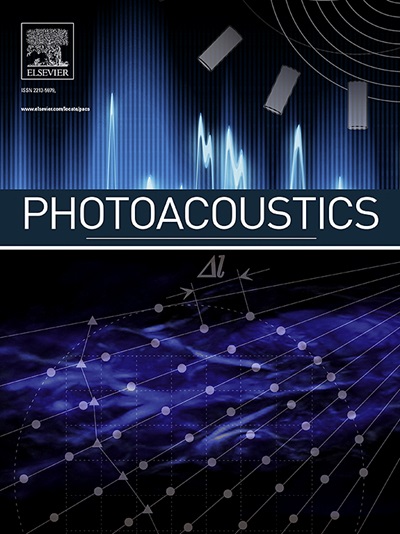High-frequency (> 65 MHz) broadband transparent transducer with ultrathin gold electrode for dual-mode photoacoustic and laser-induced ultrasound microscopy
IF 7.1
1区 医学
Q1 ENGINEERING, BIOMEDICAL
引用次数: 0
Abstract
For high-performance combined photoacoustic (PA) and Ultrasound (US) microscopy, precise coaxial alignment of the US and laser beams is essential. This can be realized using broadband transparent ultrasound transducers (TUTs). However, the current dual-mode imaging systems encounter significant challenges in simultaneous PA and US data acquisition due to sequential transmission of light and ultrasound and mechanical movement of dual-mode probes, leading to longer acquisition times and potential registration inaccuracies. To overcome these limitations, we propose a recently developed high-frequency broadband TUT with an ultrathin (< 10 nm) gold electrode, achieving a center frequency of 65.6 MHz and a –6 dB bandwidth of 71.6 %. The ultrathin gold electrode facilitates laser-induced ultrasound (LUS), enabling simultaneous acquisition of PA and US images. In vivo experiments demonstrate that LUS imaging can effectively replace conventional US imaging, offering highly efficient dual-mode PA/US imaging with minimized registration errors.
高频(bbb65 MHz)宽带透明换能器,超薄金电极,用于双模光声和激光诱导超声显微镜
对于高性能组合光声(PA)和超声(US)显微镜,精确的同轴对准的美国和激光束是必不可少的。这可以使用宽带透明超声换能器(tut)来实现。然而,由于光和超声的顺序传输以及双模探头的机械运动,目前的双模成像系统在同时采集PA和US数据时遇到了重大挑战,导致采集时间更长,并且可能出现配准不准确的情况。为了克服这些限制,我们提出了一种最近开发的高频宽带TUT,其超薄(<;10 nm)金电极,中心频率为65.6 MHz, -6 dB带宽为71.6 %。超薄金电极有利于激光诱导超声(LUS),能够同时获取PA和US图像。体内实验表明,LUS成像可以有效地取代传统的US成像,提供高效的PA/US双模成像和最小的配准误差。
本文章由计算机程序翻译,如有差异,请以英文原文为准。
求助全文
约1分钟内获得全文
求助全文
来源期刊

Photoacoustics
Physics and Astronomy-Atomic and Molecular Physics, and Optics
CiteScore
11.40
自引率
16.50%
发文量
96
审稿时长
53 days
期刊介绍:
The open access Photoacoustics journal (PACS) aims to publish original research and review contributions in the field of photoacoustics-optoacoustics-thermoacoustics. This field utilizes acoustical and ultrasonic phenomena excited by electromagnetic radiation for the detection, visualization, and characterization of various materials and biological tissues, including living organisms.
Recent advancements in laser technologies, ultrasound detection approaches, inverse theory, and fast reconstruction algorithms have greatly supported the rapid progress in this field. The unique contrast provided by molecular absorption in photoacoustic-optoacoustic-thermoacoustic methods has allowed for addressing unmet biological and medical needs such as pre-clinical research, clinical imaging of vasculature, tissue and disease physiology, drug efficacy, surgery guidance, and therapy monitoring.
Applications of this field encompass a wide range of medical imaging and sensing applications, including cancer, vascular diseases, brain neurophysiology, ophthalmology, and diabetes. Moreover, photoacoustics-optoacoustics-thermoacoustics is a multidisciplinary field, with contributions from chemistry and nanotechnology, where novel materials such as biodegradable nanoparticles, organic dyes, targeted agents, theranostic probes, and genetically expressed markers are being actively developed.
These advanced materials have significantly improved the signal-to-noise ratio and tissue contrast in photoacoustic methods.
 求助内容:
求助内容: 应助结果提醒方式:
应助结果提醒方式:


